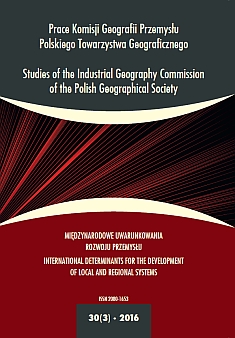Use of International Experiences or the Needs of Reclamation and Management of Post Mining Waste Dumps
DOI:
https://doi.org/10.24917/20801653.303.17Keywords:
dumping grounds after coal mining, mining wastes, reclamation processes, Upper Silesian Coal Basin area (USCB)Abstract
Mining wastes disposed on dumping grounds (tips) are parts of the landscape of every miningbasin. Post mining waste dumps require efficient technical and biological reclamation and rational management.Efficiency of reclamation of examined objects is inseparable connected with their negative environmentalimpacts, particularly self-ignition and fire hazards. These problems are also connected with recoveryof secondary resources, mainly coal particles. Described objects belong though to the perspective anthropogenicsecondary deposits. Processes of recovery are economically justified and their course is controlledby legal regulations. In the paper there are presented experiences from chosen European mining basins(UK, Belgium, Germany, Czech Republic) in range of reclamation and management of post mining dumpinggrounds, There are proposed direction of management, which could be used on coal mining waste dumps inPoland, exemplified on the Upper Silesian Coal Basin area (USCB).Downloads
Metrics
References
Gabzdyl, W. (1999). Geologia złóż. Skrypty uczelniane Politechniki Śląskiej, 2163.
Gawor, Ł. (2013). Coal-mining waste dumps as geotourist objects exemplified on Ruhr District and Upper Silesian Coal Basin – comparison and valorization analysis. Cuprum. Czasopismo Naukowo-Techniczne Górnictwa Rud, 3(68), 45–51.
Gawor, Ł. (2014). Coal mining waste dumps as secondary deposits exemplified on Upper Silesian Coal Basin and Lublin Coal Basin. Geology, Geophysis and Environment, 40(3), 285–289.
Gawor, Ł., Warcholik, W., Dolnicki, P. (2014). Możliwości eksploatacji złóż wtórnych (zwałowisk pogórniczych) jako przykład zmian w sektorze przemysłu wydobywczego. Prace Komisji Geografii Przemysłu Polskiego Towarzystwa Geograficznego, 27, 255–265.
Martinec, P. i in. (2005). The effects of coal mining on the landscapes of the Ostrava region. Moravian Geographical Reports, 13(2).
Nita, J., Myga-Piątek, U. (2006). Krajobrazowe kierunki zagospodarowania terenów pogórniczych. Przegląd Geologiczny, 54(3), 256–262.
Nyssen, J., Vermeersch, D. (2010). Slope aspect affects geomorphic dynamics of coal mining spoil heaps in Belgium. Geomorphology, 123(1–2), 109–121.
Ostręga, A. (2004). Nowatorskie rozwiązania w rekultywacji i zagospodarowaniu obszarów poprzemysłowych na przykładzie Zagłębia Ruhry w Niemczech. Przegląd Górniczy, 7–8.
Probierz, K., Marcisz, M., Sobolewski, A. (2012). Od torfu do węgli koksowych monokliny Zofiówki w obszarze Jastrzębia (SW część Górnośląskiego Zagłębia Węglowego). Zabrze: Wydawnictwo Instytutu Chemicznej Przeróbki Węgla.
Schulz, D. (2004). Recultivation of mining waste dumps in the Ruhr area, Germany. W: Water, Air & Soil Pollution, Springer Netherlands, 89–98.
Sikorska-Maykowska, M. (2001). Waloryzacja środowiska przyrodniczego i identyfikacja jego zagrożeń na terenie województwa śląskiego. Katowice: Urząd Marszałkowski Województwa Śląskiego.
Szczepańska, J., Twardowska, I. (1999). Distribution and environmental impact of coal mining wastes in Upper Silesia. Poland. Environmental Geology, 38(3), 249–258.
Tokarska-Guzik, B. (1996). Rola hałd zasadowych w utrzymaniu lokalnej bioróżnorodności. Przegląd Przyrodniczy, 7(3–4), 261–266.
Tokarska-Guzik, B. (2000). Przyrodnicze zagospodarowanie nieużytków miejsko-przemysłowych na przykładzie centrów górniczych Europy. W: Inżynieria Ekologiczna, 1. Ochrona i rekultywacja gruntów. Lublin: Wydawnictwo Ekoinżynieria, 72–80.
Uberman, R., Ostręga, A. (2004) Sposób rekultywacji i zagospodarowania zwałowisk nadkładu i składowisk odpadów górniczych. Górnictwo Odkrywkowe, 7–8.
Zásterová, P., Marschalko, M., Niemiec, D., Durdáka, J., Bulko, R., Vlcekb, J. (2015). Analysis of Possibilities of Reclamation Waste Dumps after Coal Mining. Procedia Earth and Planetary Science, 15.
Downloads
Published
How to Cite
Issue
Section
License
Articles are published under the terms of the Creative Commons License (CC BY-ND 4.0; Attribution– NoDerivs).

